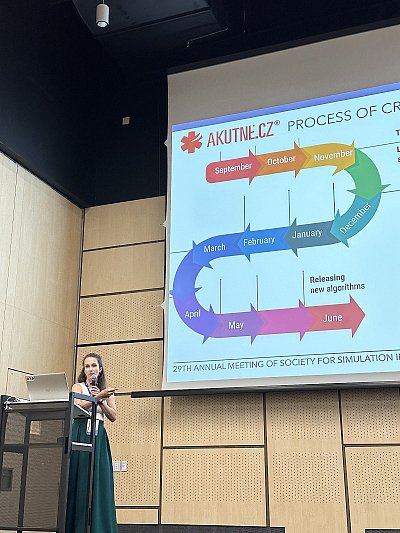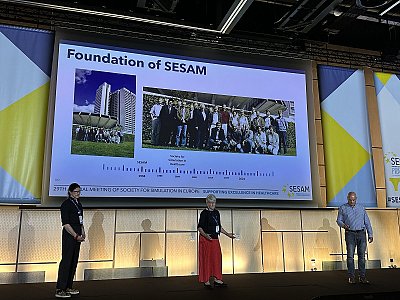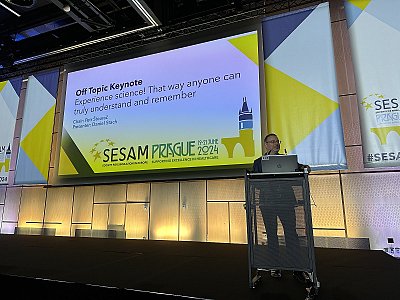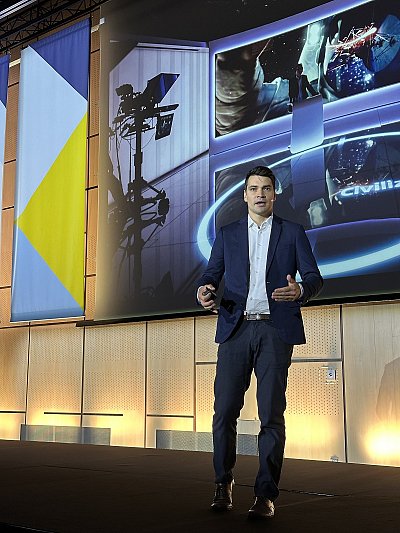Daniel Diabelko
This year's SESAM surprised me with the number of lectures and workshops focused on using generative AI in a simulation environment. For instance, I was impressed by a program for image processing and subsequent evaluation of the positions of individual participants in the simulation over time, which allowed for additional data to be gathered from the simulation. This data could be used for debriefing or assessing team skill improvement over time. Another current topic is the use of LLM models for conversational purposes. We were shown conversations between a student and an avatar with varying levels of difficulty and evaluation tables where the student had to reach a certain level of competence to advance in the course. The presented virtual avatar could even exhibit non-verbal communication. In my opinion, this is a great idea that could be applied in practice. The current GPT-4 model can converse with a latency below 150 ms, bringing us to the level of a natural and fluent conversation. The ability to express emotions during the conversation has also significantly improved. In conclusion, I would like to highlight that the SESAM 2024 conference brought many innovative ideas and technologies that can significantly improve the process of education and simulations. I am curious about how these innovations will shape the education of future students.
Veronika Krátká
This year's SESAM offered participants a truly rich program, allowing them to enjoy a variety of workshops and lectures according to their tastes in the pleasant environment of O2 Universum Congress Center. I was particularly intrigued by an interactive workshop focused on role-playing in simulations. Participants collaboratively worked through topics such as patient selection, the role of the simulated patient in the simulation itself, and debriefing, the most important part of simulations. Other workshops offered insights into the use of virtual reality in teaching Basic Life Support or the potential of artificial intelligence in education, including ultrasound. Additionally, the exhibition area allowed participants to try out advanced simulators, including virtual reality, and get a glimpse into the (hopefully) near future of healthcare education.
Tomáš Sedláček
SESAM annually provides an opportunity to meet experts who aim to take medicine to a new level. However, unlike other years, we were fortunate to have this amazing conference right here in Prague. The event showcased many aspects, from great workshops and presentations to plenary lectures with all participants. I had the opportunity to listen to an excellent lecture on “The role of simulation-based education in fostering professionalism,” where colleagues from Scotland discussed the importance of teaching not only clinical aspects but also professionalism, which accompanies clinicians throughout their lives. For each of us, professionalism is something different, and its cultivation in students is even more complex. The workshop focused on this often insufficiently mentioned topic. Another concept covered in several presentations was using “escape rooms” in simulation medicine for training healthcare professionals. The theme was highlighted in lectures and workshops like “From Puzzles to Patient Care: Learning Trauma Care & Teamwork Through Escape Room” and “Escape from Disaster - a Medical Escape Room for Team Training” or “Play & Train - simulation-based traditional games.” All of these took a slightly different approach to presenting the issue but offered great new ideas for conducting simulations, though their widespread implementation is still far off. While simulation games have a fun element that can lighten the atmosphere and reduce the risk of long-term negative psychological impacts from simulations, they also have significant challenges. Notably, they require an extraordinary pre-briefing effort and can distract from the clinical scenario when not led by an experienced facilitator. We can eagerly anticipate what further developments in this area will bring. Perhaps it won’t be long before each of us, as clinicians, is invited to teach students, and our main tool will be a lock and keys hidden in a patient's airway. If we take anything from the conference, it is a glimpse of the future. Although it is difficult to determine what this future will look like, it is being shaped in places like SESAM 2024, with the technologies (also exhibited at the conference) and us, the people willing to create that future.
Hana Harazim
This year’s SESAM congress was my very first, and I must say many things have pleasantly surprised me as much this year. The congress was an incredibly inspiring gathering of enthusiasts and innovators in simulation medicine worldwide. It was set up to ensure that you really had the chance to meet and exchange experiences. Several times a day, everyone gathered in a large hall for a Key Note Lecture – before breaking off into smaller rooms for workshops, symposia, simulations, and presentations of short communications or posters.
However, the AKUTNĚ.CZ portal was not just in the role of an observer but actively engaged in the event! Our workshop on creating a teaching lesson from an interactive algorithm on AKUTNĚ.CZ attracted a full house. Participants first had the opportunity to experience Problem-Based Learning Discussion (PBLD) firsthand in the role of students as they tackled the case of a tension pneumothorax following a bicycle accident. The authentic videos of the bicycle accident immediately captured their attention, and when they saw the rider flying over the handlebars in slow motion, everyone held their breath. Our virtual patient, however, was the one running out of breath, necessitating an intervention. Before performing thoracocentesis, participants had to consider the aspects of physical findings and the differential diagnosis of dyspnea. The fact that the patient is virtual allows for deeper knowledge exploration, seeking explanations, and arguing in team discussions. After the basic stabilization of the patient, we moved on from this activity to a look into the database of virtual patients – the interactive algorithms on AKUTNĚ.CZ. Given that there are already over 180 virtual patients, it’s not easy to choose. Working in smaller groups, participants selected one of the offered educational goals (e.g., fever, poisoning, neonates, EKG...) and then tried to find a suitable algorithm to help achieve this goal. In the final part, we explained how to “dissect” the algorithm's content into individual questions, broadly covering the topic from the perspective of anatomy, histology, physiology, propaedeutics, pharmacology, imaging and laboratory diagnostic methods, pathophysiology, and epidemiology. Participants then tried this in small groups using their selected algorithms. Finally, participants shared their impressions of the workshop – they gained a new perspective on creating a teaching lesson where students are prepared, engaged, and actively collaborating to achieve educational goals.
The next day, I had the great honour of presenting a short communication on the topic “Interactive scenarios AKUTNĚ.CZ: open access database of more than 170 virtual patients.” My goal was to inform the wide audience of educators that we have a publicly accessible, huge database of virtual patients in the Czech Republic, available to anyone with an internet connection and completely free of charge. I showed them what interactive algorithms look like, how they can be used, and what their creation involves. I was rewarded with numerous questions from the audience and appreciation for the immense scope of our work, emphasizing its unrestricted accessibility to the general public.















